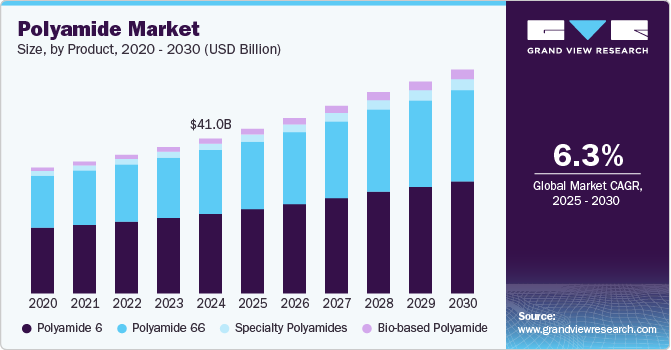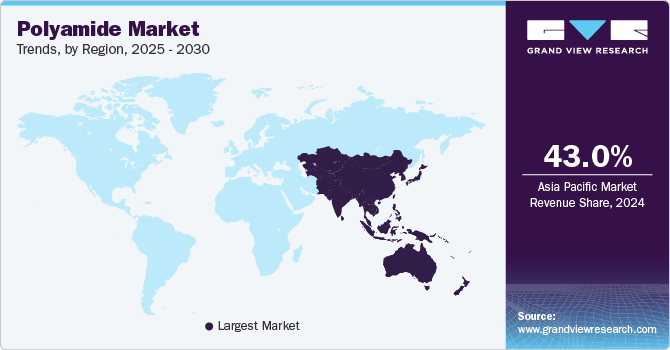
Polyamide Market Size, Share & Trends Analysis Report By Product (Polyamide 6, Polyamide 66, Bio-based Polyamide), By Application (Engineering Plastics, Fibers), By Region, And Segment Forecasts, 2025 - 2030
- Report ID: GVR-4-68038-353-9
- Number of Report Pages: 120
- Format: PDF, Horizon Databook
- Historical Range: 2018 - 2023
- Forecast Period: 2025 - 2030
- Industry: Bulk Chemicals
Polyamide Market Size & Trends
The global polyamide market size was estimated at USD 41.02 billion in 2024 and is expected to grow at a CAGR of 6.3% from 2025 to 2030. The polyamide industry is primarily driven by the growing demand from the automotive and transportation sectors, where these materials are increasingly used to replace metal components for weight reduction and improved fuel efficiency.

The expanding textile and clothing industry, particularly in emerging economies, is triggering market growth. Polyamides offer excellent durability, elasticity, and moisture-wicking properties, making them ideal for sportswear, activewear, and high-performance clothing. Major brands such as Nike, Adidas, and Under Armour regularly incorporate polyamide fibers into their premium product lines. The growing middle class in countries such as China and India has substantially increased the demand for such performance textiles.
The packaging industry represents another crucial growth factor, especially in food packaging applications. Polyamides' exceptional barrier properties against oxygen and moisture and their heat resistance make them ideal for protecting perishable foods and extending shelf life. For instance, multilayer films containing polyamide layers are widely used for meats and cheeses in vacuum packaging.
Moreover, the electrical and electronics industry represents another significant growth factor, particularly with the surge in consumer electronics and the expansion of 5G infrastructure. Polyamides are valued for their excellent electrical insulation properties and heat resistance. Companies such as Evonik AG and BASF have developed specialized polyamide grades for electronic housings, connectors, and cable ties that can withstand high temperatures and maintain dimensional stability.
Product Insights
The polyamide 6 product segment recorded the largest market revenue share of over 51.0% in 2024. Polyamide 6, known as Nylon 6, is a synthetic polymer made from a single monomer, caprolactam. It is widely used due to its excellent strength, elasticity, and resistance to wear, abrasion, and chemicals. The demand for Polyamide 6 is primarily driven by the automotive and textile industries, where the material's durability, heat resistance, and lightweight nature make it ideal for parts such as engine components, airbags, and garments.
Bio-based polyamide is projected to grow at the fastest CAGR of 11.0% during the forecast period. These polyamides are derived from renewable resources, such as castor oil, instead of petroleum-based feedstocks. They are designed to offer mechanical properties and performance similar to conventional polyamides while reducing their environmental impact. The growing environmental concerns and demand for sustainable products drive the segment's growth.
Application Insights
The engineering plastics segment recorded the largest market share of over 58.0% in 2024. The growing demand for lightweight, durable, and high-performance materials in industries such as automotive and electronics is a major driver for the polyamide-based engineering plastics market. Increasing vehicle fuel efficiency regulations and the need for more sustainable products are pushing manufacturers to opt for polyamide over metals, particularly in automotive applications.

The fibers segment is anticipated to experience the highest CAGR of 4.7% during the forecast period. Polyamide fibers, including nylon, are extensively used in the textile and apparel industries and in industrial applications like carpets, ropes, and airbags. The demand for polyamide fibers is largely driven by the growing textile and apparel industry, where the need for durable, high-performance fabrics is rising. In addition, the increasing popularity of activewear, sports clothing, and outdoor gear, which require superior fabric strength, moisture-wicking properties, and durability, is significantly boosting the market for polyamide fibers.
Region Insights
Asia Pacific polyamide market dominated and accounted for the largest revenue share of over 43.0% in 2024 and is anticipated to grow at the fastest CAGR of 5.1% over the forecast period. The region's dominance is primarily driven by China, India, and Southeast Asian countries, where rapid industrialization and manufacturing expansion have created substantial demand for polyamides across multiple sectors. For instance, China's automotive industry heavily relies on polyamide components for lightweight parts such as air intake manifolds, engine covers, and fuel lines. Moreover, the textile industry in Asia Pacific is another major contributor to polyamide demand, particularly in countries like Vietnam, Bangladesh, and Indonesia. These nations have established themselves as global textile manufacturing hubs, with polyamide fibers (nylon) essential in producing sportswear, outdoor gear, and technical textiles.

China Polyamide Market Trends
China polyamide market is primarily driven by its massive manufacturing base, particularly in automotive, electronics, and textiles, whichcreates substantial demand for polyamide materials. The automotive sector alone accounts for a significant portion of consumption, using polyamides in components such as air intake manifolds, engine covers, and fuel lines. The Chinese government's strategic focus on advanced materials and sustainable development has further accelerated market growth. Through initiatives like "Made in China 2025" and the 14th Five-Year Plan, substantial investments have been directed toward chemical industry upgrades and research & development. This has resulted in improved production capabilities for high-performance polyamides.
North America Polyamide Market Trends
The North America polyamide market is primarily driven by its robust automotive and aerospace industries, which are major consumers of these engineering plastics. The region's automotive sector, particularly in the United States and Mexico, is increasingly adopting polyamides for manufacturing lightweight components to meet stricter fuel efficiency standards. For example, major automakers such as General Motors and Ford use polyamide-based materials for engine covers, air intake manifolds, and fuel line components, driving significant market growth.
The U.S. polyamide market is primarily driven by a mature manufacturing infrastructure and strong supply chain networks. The country's strategic location and well-developed logistics capabilities enable efficient distribution of polyamide products domestically and internationally. The shale gas boom has also provided U.S. manufacturers with cost-competitive raw materials for polyamide production.
Europe Polyamide Market Trends
The polyamide market in Europe is driven by several key factors that interconnect with its industrial strengths and regulatory environment. The region's robust automotive and aerospace sectors are primary drivers, with manufacturers such as Volkswagen, BMW, and Airbus increasingly using polyamides to reduce vehicle weight and improve fuel efficiency. Moreover, the region's stringent environmental regulations, particularly the EU's push toward sustainable materials and circular economy initiatives, have spurred innovation in bio-based and recycled polyamides.
Polyamide market in Germany is primarily driven by its strong chemical industry infrastructure, anchored by companies such as BASF, Lanxess, and Evonik AG, whichprovides a competitive advantage in polyamide production. These companies have established extensive R&D facilities and production plants across Germany, enabling them to develop specialized grades of polyamides for specific applications. For instance, BASF's Ultramid product line includes various polyamide formulations optimized for different industrial uses, from automotive parts to consumer goods.
Key Polyamide Company Insights
The global polyamide industry's competitive environment is characterized by the presence of several key players, including BASF, Evonik AG, Arkema, and Solvay. These companies compete intensely, driven by product innovation, advanced material technologies, and strategic partnerships to cater to diverse end-use industries such as automotive, electronics, and packaging. In addition, increasing investment in R&D for bio-based and recyclable polyamides is shaping the competitive landscape, with smaller players and startups gaining traction by offering eco-friendly alternatives.
Key Polyamide Companies:
The following are the leading companies in the polyamide market. These companies collectively hold the largest market share and dictate industry trends.
- BASF
- Evonik AG
- Arkema
- Solvay
- Domo Chemicals
- DSM-Firmenich
- Lanxess
- DuPont
- TORAY INDUSTRIES, INC.
- Ascend Performance Materials
- Koch IP Holdings, LLC.
- Advansix
- Celanese Corporation
- Huntsman International LLC
- Mitsui Chemicals
View a comprehensive list of companies in the Polyamide Market
Recent Developments
-
In April 2024, DOMO Chemicals, a prominent global player in the engineering materials sector specializing in polyamides, inaugurated a new USD 14.7 million production plant for TECHNYL polyamides in Haiyan, Jiaxing, Zhejiang, China. This facility, which covers an area of 40,000 square meters, is designed to enhance the company’s production capacity from 25,000 tons to 35,000 tons initially, with a long-term goal of reaching 50,000 tons.
-
In January 2024, BASF and Inditex significantly advanced textile recycling by introducing Loopamid, the first circular nylon 6 entirely derived from textile waste. This innovative solution addresses the growing need for sustainability in the fashion industry by enabling the recycling of polyamide 6 (PA6) materials, commonly known as nylon 6.
Polyamide Market Report Scope
|
Report Attribute |
Details |
|
Market size value in 2025 |
USD 43.57 billion |
|
Revenue forecast in 2030 |
USD 59.27 billion |
|
Growth rate |
CAGR of 6.3% from 2025 to 2030 |
|
Historical data |
2018 - 2023 |
|
Forecast period |
2025 - 2030 |
|
Quantitative units |
Volume in kilotons, revenue in USD million/billion, and CAGR from 2025 to 2030 |
|
Report coverage |
Revenue forecast, competitive landscape, growth factors, and trends |
|
Segments covered |
Product, application, region |
|
States scope |
North America; Europe; Asia Pacific; Central & South America; Middle East & Africa |
|
Key companies profiled |
BASF; Evonik AG; Arkema; Solvay; Domo Chemicals; DSM-Firmenich; Lanxess; DuPont; TORAY INDUSTRIES, INC.; Ascend Performance Materials; Koch IP Holdings, LLC.; Advansix; Celanese Corporation; Huntsman International LLC; Mitsui Chemicals |
|
Customization scope |
Free report customization (equivalent up to 8 analyst’s working days) with purchase. Addition or alteration to country, regional, and segment scope. |
|
Pricing and purchase options |
Avail customized purchase options to meet your exact research needs. Explore purchase options |
Global Polyamide Market Report Segmentation
This report forecasts revenue growth at a global level and provides an analysis of the latest industry trends in each of the sub-segments from 2018 to 2030. For this study, Grand View Research has segmented the global polyamide market report based on product, application, and region:

-
Product Outlook (Volume, Kilotons; Revenue, USD Million, 2018 - 2030)
-
Polyamide 6
-
Polyamide 66
-
Bio-based Polyamide
-
Specialty Polyamides
-
-
Application Outlook (Volume, Kilotons; Revenue, USD Million, 2018 - 2030)
-
Engineering Plastics
-
Automotive
-
Electrical & Electronics
-
Consumer Goods & Appliances
-
Packaging
-
Others
-
-
Fibers
-
Textile
-
Carpet
-
Others
-
-
-
Region Outlook (Volume, Kilotons; Revenue, USD Million, 2018 - 2030)
-
North America
-
U.S.
-
Canada
-
Mexico
-
-
Europe
-
Germany
-
France
-
UK
-
Italy
-
Spain
-
-
Asia Pacific
-
China
-
India
-
Japan
-
Australia
-
Southeast Asia
-
-
Central & South America
-
Brazil
-
Argentina
-
-
Middle East & Africa
-
South Africa
-
Saudi Arabia
-
UAE
-
-
Frequently Asked Questions About This Report
b. The global polyamide market size was estimated at USD 41.02 billion in 2024 and is expected to reach USD 43.57 billion in 2025.
b. The global polyamide market is expected to grow at a compound annual growth rate of 6.3% from 2025 to 2030 to reach USD 59.27 billion by 2030.
b. Asia-Pacific dominated the Polyamide market with a share of over 43.0% in 2024. This is attributable to the region's robust manufacturing sector, particularly in countries such as China, Japan, South Korea, and India. Additionally, the expansion of the automotive sector is benefiting the market in the region.
b. Some key players operating in the polyamide market include BASF; Evonik AG; Arkema; Solvay; Domo Chemicals; DSM-Firmenich; Lanxess; DuPont; TORAY INDUSTRIES, INC.; Ascend Performance Materials; Koch IP Holdings, LLC.; Advansix; Celanese Corporation; Huntsman International LLC; and Mitsui Chemicals.
b. Key factors that are driving the polyamide market growth include increasing demand in the automobile industry and electrical & electronics sectors across the world.
We are committed towards customer satisfaction, and quality service.
"The quality of research they have done for us has been excellent."




